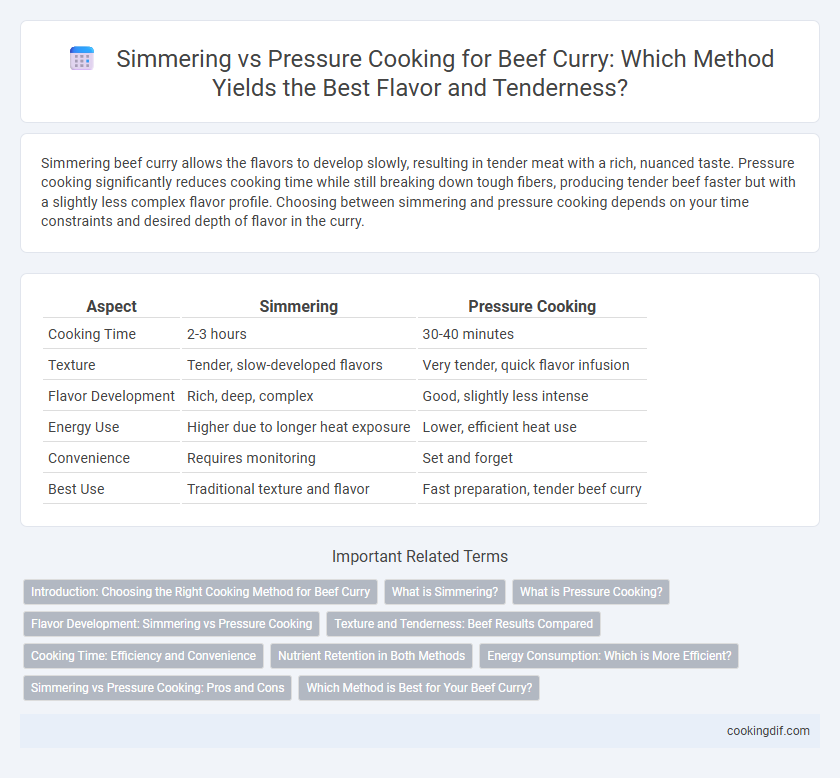Simmering beef curry allows the flavors to develop slowly, resulting in tender meat with a rich, nuanced taste. Pressure cooking significantly reduces cooking time while still breaking down tough fibers, producing tender beef faster but with a slightly less complex flavor profile. Choosing between simmering and pressure cooking depends on your time constraints and desired depth of flavor in the curry.
Table of Comparison
| Aspect | Simmering | Pressure Cooking |
|---|---|---|
| Cooking Time | 2-3 hours | 30-40 minutes |
| Texture | Tender, slow-developed flavors | Very tender, quick flavor infusion |
| Flavor Development | Rich, deep, complex | Good, slightly less intense |
| Energy Use | Higher due to longer heat exposure | Lower, efficient heat use |
| Convenience | Requires monitoring | Set and forget |
| Best Use | Traditional texture and flavor | Fast preparation, tender beef curry |
Introduction: Choosing the Right Cooking Method for Beef Curry
Simmering allows beef to slowly absorb spices and develop deep, rich flavors while maintaining tender yet firm texture, making it ideal for traditional beef curry recipes. Pressure cooking drastically reduces cooking time by quickly tenderizing tough cuts of beef, preserving intensity of flavor with less evaporation and enhanced infusion of spices. Selecting the right method depends on balancing desired texture, flavor complexity, and time constraints for an authentic beef curry experience.
What is Simmering?
Simmering is a cooking technique that involves maintaining a liquid just below the boiling point, around 185-205degF (85-96degC), allowing beef curry to cook slowly and evenly. This method helps break down tough fibers in beef, resulting in tender, flavorful meat infused with spices. Simmering preserves the rich texture and depth of traditional beef curry, making it ideal for slow-cooked dishes that benefit from gradual heat.
What is Pressure Cooking?
Pressure cooking utilizes high steam pressure to rapidly cook beef curry, significantly reducing cooking time while locking in flavors and tenderizing meat efficiently. Compared to simmering, which gently cooks beef over low heat for extended periods, pressure cooking achieves similar or better results in a fraction of the time by increasing temperature and pressure inside a sealed pot. This method preserves nutrients and enhances the depth of flavor in beef curry, making it a preferred choice for quick, flavorful meals.
Flavor Development: Simmering vs Pressure Cooking
Simmering beef curry over low heat allows gradual flavor development as spices and meat juices meld, enhancing depth and richness with prolonged cooking. Pressure cooking significantly reduces cooking time while intensifying flavors by locking in steam and heat, producing tender beef with concentrated taste. However, simmering generally yields a more nuanced and complex flavor profile compared to the faster, more uniform taste from pressure cooking.
Texture and Tenderness: Beef Results Compared
Simmering beef curry results in slowly tenderized meat with a rich, developed flavor but can sometimes yield a firmer texture due to prolonged gentle heat. Pressure cooking accelerates the tenderization process, producing exceptionally soft and juicy beef in a fraction of the time while locking in moisture and enhancing the meat's succulence. Comparing both methods, pressure cooking delivers superior tenderness and a smoother texture, ideal for quick preparation without sacrificing flavor depth.
Cooking Time: Efficiency and Convenience
Simmering beef curry typically takes 1.5 to 2 hours, allowing flavors to develop deeply but requiring constant monitoring and longer cooking time. Pressure cooking reduces this process to 30-45 minutes, offering significant efficiency and convenience without sacrificing tenderness. This method is ideal for busy kitchens looking to maintain rich taste with expedited preparation.
Nutrient Retention in Both Methods
Simmering beef curry allows for a slower cooking process that helps preserve heat-sensitive vitamins like vitamin C and B-complex while maintaining rich flavors through gradual ingredient melding. Pressure cooking significantly reduces cooking time, which can better retain certain water-soluble nutrients but may cause some loss of heat-sensitive compounds due to higher temperatures. Both methods maintain protein content effectively, but simmering tends to preserve more antioxidants and flavor compounds, enhancing overall nutrient quality in the curry.
Energy Consumption: Which is More Efficient?
Simmering beef curry typically consumes more energy due to longer cooking times, often exceeding two hours, whereas pressure cooking reduces cooking duration to under an hour by utilizing high-pressure steam. Pressure cookers maintain higher temperatures and pressure, maximizing heat transfer efficiency and minimizing energy waste, making them significantly more energy-efficient. Choosing pressure cooking can cut energy consumption by up to 70% compared to simmering, benefiting both environmental impact and utility costs.
Simmering vs Pressure Cooking: Pros and Cons
Simmering beef curry allows flavors to develop slowly, enhancing richness and tenderness while maintaining control over texture but requires longer cooking times. Pressure cooking significantly reduces cooking time by using high steam pressure to break down tough fibers quickly, though it can sometimes lead to overcooked or less nuanced flavors. Choosing between simmering and pressure cooking depends on desired depth of flavor versus convenience and time efficiency.
Which Method is Best for Your Beef Curry?
Simmering beef curry allows flavors to develop gradually, resulting in tender meat and a rich, well-balanced sauce, ideal for traditional, slow-cooked dishes. Pressure cooking significantly reduces cooking time while still tenderizing tougher cuts like chuck or brisket, making it perfect for quick meals without sacrificing texture. Choosing between simmering and pressure cooking depends on your schedule and desired flavor intensity, with simmering offering depth and pressure cooking providing efficiency.
Simmering vs pressure cooking for beef curry Infographic

 cookingdif.com
cookingdif.com